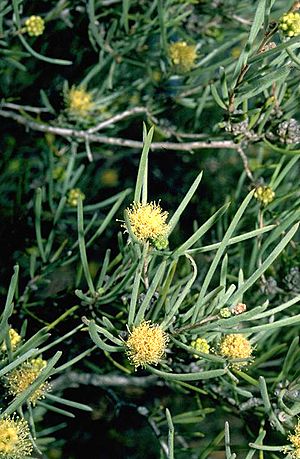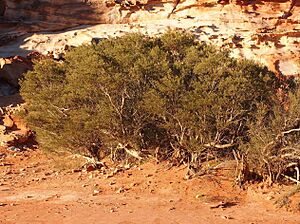Desert honey-myrtle facts for kids
Quick facts for kids Desert honey-myrtle |
|
|---|---|
 |
|
| Scientific classification | |
| Genus: |
Melaleuca
|
| Species: |
glomerata
|
The Desert Honey-Myrtle (scientific name: Melaleuca glomerata) is a special plant found in the dry, inland parts of Australia. People also call it the inland paperbark or white tea-tree. It belongs to the myrtle family, just like eucalyptus trees. This plant usually grows as a small tree or a shrub. You can often spot it in dry creek beds or low, wet areas.
What it Looks Like
The Desert Honey-Myrtle is a small tree or shrub. It can grow from 3–10 m (10–30 ft) tall. It has branches that spread out or look a bit messy. Its bark is white and feels like paper.
The leaves are usually long and thin, like lines. They come to a point at the end. Each leaf is about 10–50 mm (0.4–2 in) long and 1–2 mm (0.04–0.08 in) wide. They are a grey-green color. Some leaves have a few hairs, while others are covered in many flat hairs.
This plant produces many flowers. They grow in thick white to yellow clusters. These clusters appear where leaves join the stem or at the ends of branches. Each flower has five groups of stamens, which are the parts that hold pollen. Each group has four to nine stamens. The Desert Honey-Myrtle usually flowers in late spring to early summer. However, it can bloom at other times in its natural home.
After flowering, the plant grows small, round fruits. These fruits are about 2–2.5 mm (0.08–0.1 in) across. They grow in tight clusters.
How it Got its Name
The scientific name Melaleuca glomerata was first officially written down in 1859. This was done by a scientist named Ferdinand von Mueller. He wrote about it in a report about plants found during an expedition.
The second part of its name, glomerata, comes from a Latin word. It means "collected into a head." This name was chosen because the plant's fruits grow in tight clusters, like a head.
Where it Grows
The Desert Honey-Myrtle lives in the dry parts of Australia. You can find it in the far northwest of New South Wales. It also grows in South Australia, including the Flinders Ranges. It is found in the Northern Territory and Western Australia too.
In Western Australia, it grows in many different areas. These include places like the Carnarvon and Pilbara regions. It also grows in deserts like the Gibson Desert and Great Sandy Desert. This plant likes to grow in red sand, clay, and sandy soil. You can often see it in rocky river beds, shallow dips in the land, and flat sandy areas.
Is it Protected?
The Government of Western Australia's Department of Parks and Wildlife says that Melaleuca glomerata is "not threatened." This means it is not currently in danger of disappearing.
Using it in Gardens
This type of melaleuca is a strong and flexible plant for growing in gardens. It can be planted in most parts of Australia. It does well in both dry and warm areas. It can also grow in many types of soil, even those that are a bit salty. The Desert Honey-Myrtle has been used as a street tree in the town of Port Augusta.


